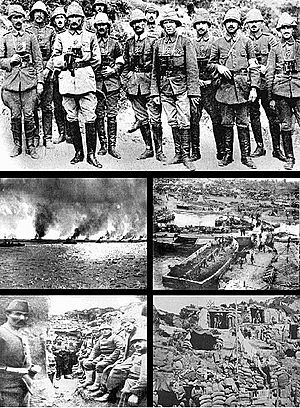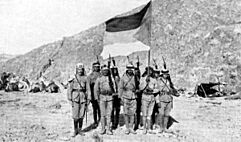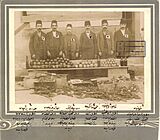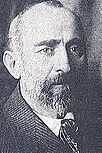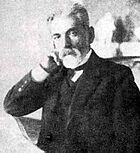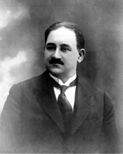Ottoman Empire in World War I facts for kids
The Ottoman Empire was a powerful empire that joined the Central Powers during World War I. It entered the war on October 29, 1914, with a surprise attack on Russia. This led Russia and its allies to declare war on the Ottomans. Ottoman forces fought against the Allied Powers in the Balkans and the Middle East. The empire's defeat in 1918 led to its complete breakup by 1922.
Contents
Joining World War I
The Ottoman Empire joined World War I after two of its newly bought ships, still run by German crews, attacked Russian ports. This happened on October 29, 1914. Many things influenced the Ottoman government to enter the war. The empire had been weakened by the Balkan Wars of 1912 and 1913. Its economy was mostly based on farming, not modern industry.
Declaration of Holy War
In November 1914, Mehmed V, the Sultan of the Ottoman Caliphate, declared a Jihad (a call for religious struggle) against the Allied Powers. This declaration asked Muslims to support the Ottomans. It called for a holy war against "all enemies of the Ottoman Empire," except the Central Powers.
Some historians say this call did not unite all Muslims. However, others believe it had a big impact. For example, the 1915 Singapore Mutiny might have been influenced by it. The declaration also helped the Ottomans get support from Kurdish tribes. These tribes played a role in the events against Armenians and Assyrians.
The war's end led to the end of the caliphate. The Ottoman Empire lost the war and faced harsh conditions. Later, a war hero named Mustafa Kemal overturned these conditions. He was a secular leader who later ended the caliphate completely.
Military Actions
The Ottoman Empire officially entered World War I on October 29, 1914. This was when it attacked Russian ports in the Black Sea. Russia declared war on November 2, followed by Britain and France on November 5, 1914. The Ottomans had secretly allied with the Central Powers in August 1914.
Moving troops and supplies across the large land of Anatolia was very hard. The roads and railways were not ready for war. It took over a month to reach Syria and almost two months to reach Mesopotamia. Because of poor supply ships, it took less time to reach these fronts from London than from Istanbul.
The empire faced some internal problems when war was declared. There were plots against Germans and the ruling party, the Committee of Union and Progress (CUP). Some CUP leaders were shot. There were also anti-German protests and riots in different cities. Soldiers and navy crews sometimes mutinied.
Military power was mostly held by War Minister Enver Pasha. Interior Minister Talat Pasha handled civil matters. Cemal Pasha had full control over Ottoman Syria. Local governors had different levels of power.
War with Russia
The Ottomans joining the war added to the challenges for Russia and its allies. Russia had to fight the Ottomans in the Caucasus Campaign and the Persian Campaign. Enver Pasha wanted to take back Batum and Kars and control oil fields. However, the Ottomans lost many battles and over 100,000 soldiers in the Caucasus.
In December 1917, Russia and the Ottomans signed a ceasefire. Then, in March 1918, the Ottomans signed the Treaty of Brest-Litovsk with Russia. This treaty gave the Ottomans back Batum, Kars, and Ardahan. It also secretly required Russia to remove Armenian forces.
In April 1918, the Ottoman army attacked Armenia. They fought battles like the Battle of Sardarapat. On May 28, 1918, the First Republic of Armenia was declared. It was then forced to sign the Treaty of Batum with the Ottomans.
Later, in July 1918, the Ottomans fought the Battle of Baku to capture Baku on the Caspian Sea.
War with Britain
The British captured Basra in November 1914 and moved north into Iraq. Ahmed Djemal Pasha was ordered to gather an army in Palestine to threaten the Suez Canal. The Suez Canal was very important for British war efforts.
In response, the Allies, including the Australian and New Zealand Army Corps ("ANZACs"), opened another front. This was the Battle of Gallipoli. The Ottoman army, led by Ahmed Djemal Pasha, tried to remove the British from Egypt. They were stopped at the Suez Canal in February 1915 and again the next summer.
The British invasion came through the Dardanelles straits. The goal of the Dardanelles campaign was to help Russia. At Gallipoli, Mustafa Kemal saw how capable his soldiers were with good leadership. The war was like something from an older time. Ottoman officers led charges with swords, and troops shouted "Allahu Akbar!" as they attacked.
Great Britain had to protect India and its oil fields in southern Persia. This led to the Mesopotamian campaign. Britain also had to protect Egypt in the Sinai and Palestine Campaign. These campaigns used up many Allied resources, which helped Germany.
In 1917, British forces pushed back the Ottomans in Palestine. Jerusalem was lost in December of that year. The Ottoman authorities also moved the entire civilian population of Jaffa in April 1917. While Muslims could return, Jewish people could not until after the war. This happened around the same time as the Balfour Declaration. This declaration stated British support for a Jewish homeland in Palestine.
The Ottomans were eventually defeated by key attacks from the British general Edmund Allenby.
The Home Front
The war put a lot of strain on the empire's relationship with its Arab people. In Syria, Cemal Pasha had total power over military and civil matters. He believed an Arab uprising was coming. Many Arab leaders were executed, and important families were sent away to Anatolia.
Cemal's actions did not help the famine in Syria. This famine was made worse by British and French blockades. Britain also supported Arab nationalist ideas to use against the Ottoman Empire. Sharif Hussein ibn Ali rebelled against Ottoman rule in the Arab Revolt of 1916. By October, he declared himself king of Arabia. On October 3, 1918, Arab Revolt forces entered Damascus with British troops. This ended 400 years of Ottoman rule there.
Soldiers leaving their posts, called desertion, also became a big problem. Low morale and lack of supplies meant many soldiers left the army. Some even became bandits, controlling large areas behind the front lines.
War in Eastern Europe
To help the other Central Powers, Enver Pasha sent about 100,000 Ottoman soldiers to fight in Eastern Europe.
- The VI Corps fought in the Romanian Campaign from September 1916 to April 1918.
- The XV Corps fought in Galicia against the Russians from August 1916 to August 1917.
- The XX Corps fought in the Salonika Campaign from December 1916 to May 1917.
Foreign Relations
The Ottoman–German Alliance was formed on August 2, 1914, soon after World War I began. This alliance aimed to strengthen the Ottoman military and allow Germany to pass through Ottoman lands to reach British colonies.
1915
The Constantinople Agreement on March 18, 1915, was a secret deal. Great Britain promised to give Constantinople and the Dardanelles to Russia if the Allies won the war.
During 1915, British forces ended an agreement with the Ottomans. They declared Kuwait an "independent sheikdom under British protection."
1917
In 1917, the Ottoman government thought about keeping ties with Washington. This was after the United States declared war on Germany on April 6. But the war party wanted to stay united with their allies. So, relations with America were broken on April 20, 1917.
Russian Revolution
The 1917 Russian Revolution changed everything. The war had badly damaged Russia's economy. The Russian government's desire to control Eastern Anatolia and the straits led to its own downfall. Not being able to use the straits badly affected Russia's supply chain.
Enver Pasha immediately told the Third Army to ask Russia's Caucasus Army for a ceasefire. On December 7, 1917, the Bolshevik Party, led by Vladimir Lenin, took over Russia. This led to many civil wars within Russia. The slow breakup of Russia's Caucasus Army removed one military threat but brought another.
On December 15, an armistice was signed between Russia and the Central Powers. On December 18, the Armistice of Erzincan was signed. The Bolsheviks wanted peace with no land taken or payments. This was similar to the Ottoman position.
The Treaty of Brest-Litovsk was a huge success for the Ottoman Empire. The foreign minister announced this peace to the government. He believed the Allies would soon stop fighting and the war would end quickly. The treaty gave the Ottomans back Kars, Ardahan, and Batum.
1918
The Ottoman government believed its role in the war was very important. Ottoman armies had kept many Allied troops busy on different fronts. This kept them away from Europe, where they would have fought German and Austrian forces. They also believed their success at Gallipoli helped cause Russia's collapse and the revolution. Enver Pasha remained hopeful, hiding information that made the Ottoman position look weak. He made most Ottoman leaders believe the war could still be won.
Caucasus (Armenia–Azerbaijan–Georgia)
The Ottoman policy towards the Caucasus changed as the war went on. The idea of "self-determination" became important. This meant giving new states a chance to stand on their own. The Ottomans did not think these new states could stand against a new Russia. These new Muslim states needed help to become independent.
The Ottoman Empire recognized the Transcaucasian Democratic Federative Republic in February 1918. On May 11, a new peace conference began at Batum. The Treaty of Batum was signed on June 4, 1918. It was signed between the Ottoman Empire and three Trans-Caucasus states: First Republic of Armenia, Azerbaijan Democratic Republic, and Democratic Republic of Georgia.
The Ottomans wanted to help the Azerbaijan Democratic Republic at the Battle of Baku. Then they planned to move north to help the Mountainous Republic of the Northern Caucasus. After that, they aimed to move south to surround the British in Mesopotamia and retake Baghdad.
Armistice
Events in Southeast Europe crushed the Ottoman government's hopes. In September 1918, Allied forces launched a sudden attack on the Macedonian front. This attack was very successful. Bulgaria was forced to ask for peace in the Armistice of Salonica. This hurt both Germany and the Ottomans. Germany had no troops to spare, and the Ottomans suddenly faced defending Istanbul without help from Bulgaria.
Grand Vizier Talaat Pasha visited Berlin and Sofia in September 1918. He realized the war could no longer be won. With Germany likely seeking its own peace, the Ottomans would have to do the same. Talaat convinced other ruling party members that they must resign. This was because the Allies would impose harsher terms if the people who started the war were still in power. On October 13, Talaat and his government resigned. Ahmed Izzet Pasha became the new Grand Vizier.
Two days later, Ahmed Izzet Pasha sent the captured British General Charles Vere Ferrers Townshend to the Allies to ask for an armistice. The British government decided they should handle the negotiations alone. They wanted to keep the French from getting land promised in the Sykes-Picot agreement. The negotiations began on October 27 on a British ship. The British refused to let the senior French naval officer join the talks. The Ottoman team was led by Rauf Bey.
Both sides were very eager to sign a deal. The British had a list of 24 demands. But they were told to give in on any of them except allowing occupation of the Dardanelles forts and free passage through the Bosphorus. The British wanted access to the Black Sea. The Ottomans believed the war was lost and would accept almost any demands. As a result, the initial draft from the British was accepted with few changes. The Ottomans did not know they could have pushed back on most clauses. The British did not know they could have demanded even more. The Ottomans gave the Allies the right to occupy any Ottoman territory "in case of disorder." This was a vague and broad clause.
Politics
On October 30, 1918, the Armistice of Mudros was signed. This ended the Ottoman Empire's involvement in World War I. However, the Ottoman public was given misleadingly positive information about the armistice terms. They thought the terms were much easier than they actually were. This later caused unhappiness, as people felt the Allies had betrayed the promised terms.
Aftermath
Casualties
The Ottoman Empire called up 3 million men for World War I. It lost 325,000 soldiers killed in action. Hundreds of thousands more died from disease or other causes. Another 400,000 were injured. About 202,000 men were taken prisoner, mostly by the British and Russians. One million soldiers left their posts. This left only 323,000 men in the army when the armistice was signed.
If the Ottoman Empire had not joined the war, the Allied victory might have been faster.
Financial Losses
The financial losses were huge. The empire spent 398.5 million Ottoman Lira, which was about 9.09 billion gold francs at the time. The empire was almost bankrupt by 1918.
Events Against Civilian Populations
During World War I, the Ottoman Empire carried out systematic actions against some groups of people living in its territory. This included the Armenian genocide, sometimes called the Armenian Holocaust. This was the Ottoman government's planned extermination of 1.5 million Christian Armenians. Most of them were Ottoman citizens.
The events began on April 24, 1915. On this day, Ottoman authorities arrested and deported Armenian thinkers and community leaders from Constantinople. Most of them were later killed. The actions happened during and after World War I. They involved two main parts: the killing of able-bodied men and forcing army conscripts into hard labor. Then, women, children, the elderly, and the sick were forced on long marches into the Syrian desert. These people were deprived of food and water. They also faced robbery and mass killings.
Other Christian groups, like the Assyrians and the Ottoman Greeks, were also targeted. These events are sometimes called the Assyrian genocide and the Greek genocide. Some historians believe these actions were part of the same plan. Many Armenian diaspora communities around the world exist today because of these events.
The Armenian genocide is seen as one of the first modern genocides. Scholars point to the organized way the killings were done to eliminate the Armenians. It is the second most studied case of genocide after the Holocaust.







